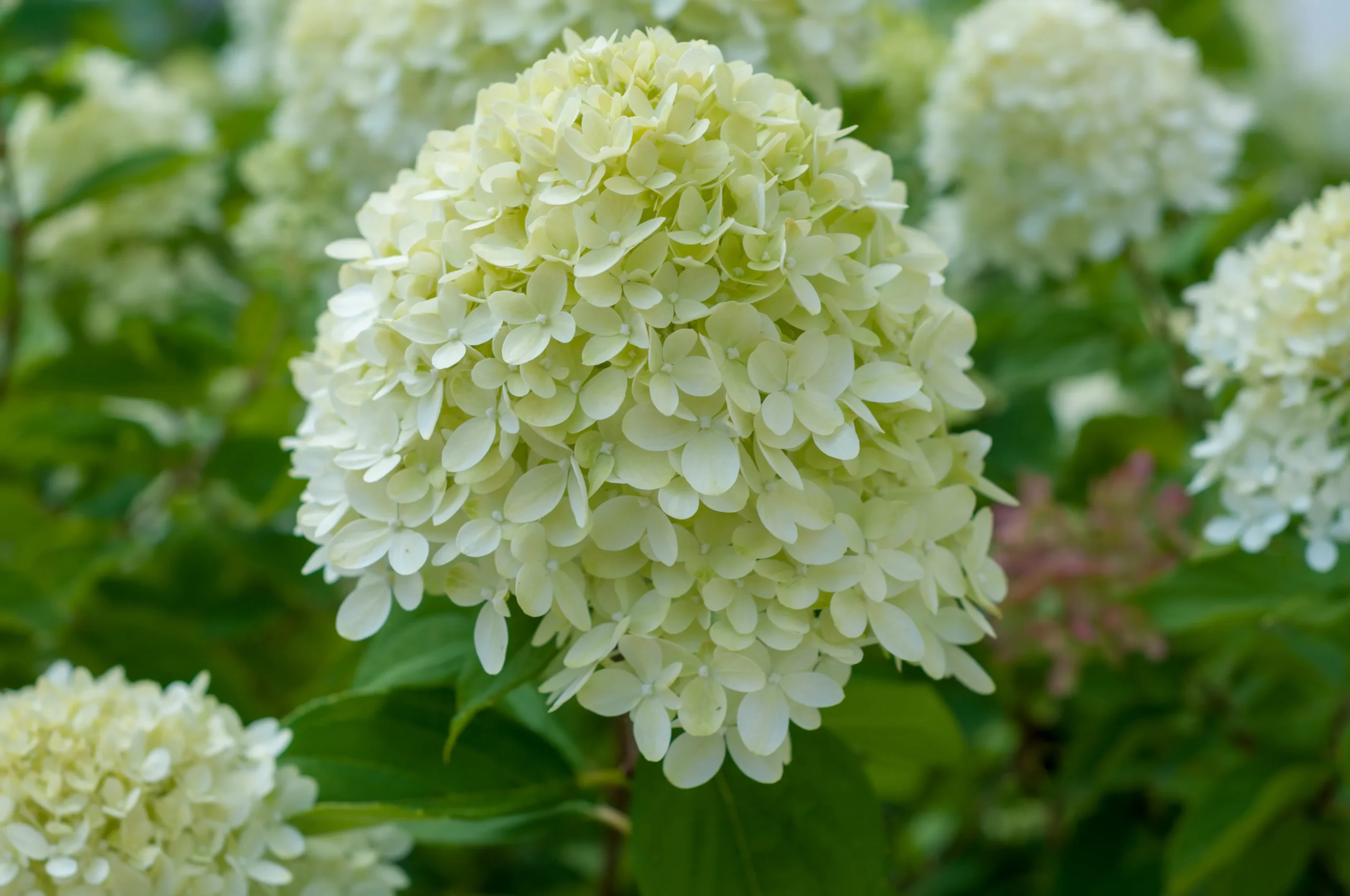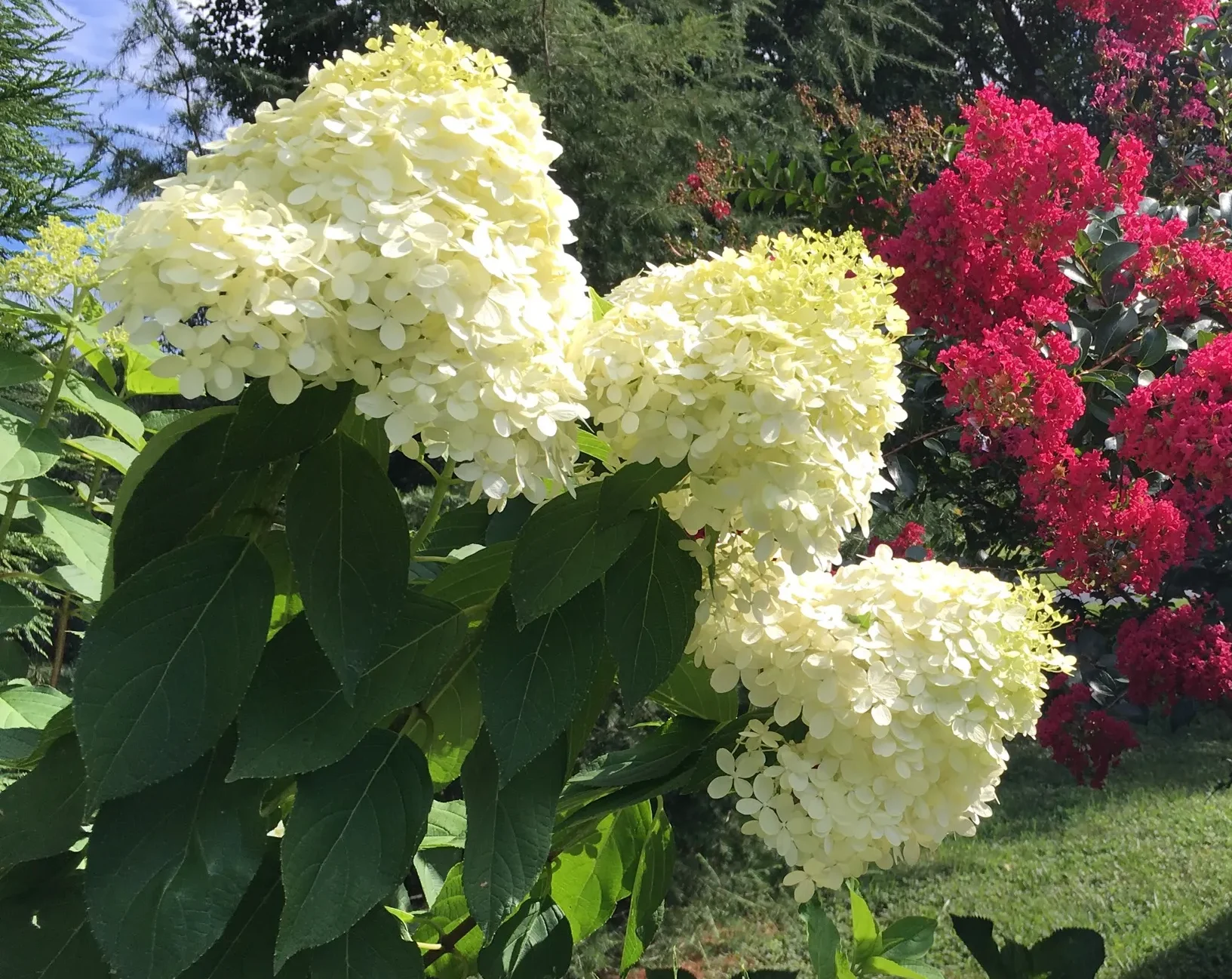Family: Hydrangea
Type: Shrub

The Limelight Hydrangea Tree, a cultivated form of the popular Limelight Hydrangea, stands as a testament to the beauty and versatility of hydrangeas. This deciduous tree dazzles with its large, lime-green flowers that bloom from summer to fall, transitioning to pink, red, and burgundy as the seasons change. Its unique tree form, created by grafting onto a standard, elevates the appeal of the hydrangea, allowing it to serve as a striking focal point in any landscape.
Ideal for small gardens and spaces where a traditional tree might be too large, the Limelight Hydrangea Tree reaches a manageable height of 6-8 feet tall. Its compact size, however, does not detract from its visual impact. The tree’s bold, bright blooms and lush foliage create a dramatic display that can enhance the aesthetic of any outdoor area. Furthermore, it’s as resilient as it is beautiful, adapting well to a variety of soil conditions and withstanding urban pollution, making it a suitable choice for both rural and urban gardens.
Adding a Limelight Hydrangea Tree to your garden not only introduces a stunning visual element but also attracts pollinators, adding life and movement to your outdoor space. Its ease of care, combined with its show-stopping blooms, makes it an excellent option for gardeners looking to make a statement with minimal effort. Whether used as a specimen plant, in mixed borders, or as part of a formal garden, the Limelight Hydrangea Tree is sure to captivate and charm year after year.
Hardiness Zone: 4a-9a
Pet Friendly: Yes
Moisture Preference: Average to moist
Sun Needs: Full sun to shade
Growth Rate: Medium
Average Height (feet): 6
Average Spread (feet): 7
Average Life Span (years): 40
Form: Lollipop
Flower Color: Green
Secondary Flower Color: White
Bloom Season: From mid summer to late fall
Foliage Color: Green
Foliage Shape: Pointy
Bark Color: Gray
Bark Texture: Smooth
Incorporating the Limelight Hydrangea Tree into your yard can transform any garden into a showcase of vibrant color and elegant form. When planted as a stand-alone specimen, it draws the eye, serving as an impressive anchor for garden design. Its vertical growth habit allows it to fit seamlessly into small or narrow spaces, providing height and structure without overwhelming the area.
For a dynamic garden composition, pair the Limelight Hydrangea Tree with low-growing perennials and shrubs that complement its color and form. This creates layers of interest, with the hydrangea tree’s striking blooms standing tall above the rest. Placing it near outdoor living areas, such as patios or decks, brings its beauty close to where it can be most enjoyed, enhancing the ambiance of outdoor gatherings.
Utilizing the Limelight Hydrangea Tree in formal gardens adds an element of sophistication, while its natural charm is a perfect fit for cottage and country garden styles. Its adaptability and dramatic presence make it a versatile choice for many garden designs, enriching the landscape with its unique character and long-lasting blooms.

The Limelight Hydrangea Tree's lush blooms and informal growth habit blend beautifully into the relaxed, overflowing style of cottage gardens.
In modern garden settings, its clean lines and distinct form offer a striking contrast to minimalist, contemporary designs.
Its symmetrical shape and elegant blooms lend themselves well to formal gardens, where it can serve as a captivating focal point.
Plant it as a central feature in a circular bed, surrounded by lower plants, to create a stunning island of color and texture.
Use the Limelight Hydrangea Tree to line a driveway or walkway, its uniform shape providing rhythm and visual interest.
Incorporate it into a moon garden, where its light-colored blooms will reflect the moonlight, adding brightness and allure to the evening landscape.
Select our pre-made garden layouts to create a landscape that’s uniquely yours. Simple, smart, and customizable!
In spring, the Limelight Hydrangea Tree begins to leaf out, promising the spectacular blooms that will follow.
The height of its beauty occurs in summer, when it becomes covered in large, lime-green flowers that cool the landscape.
As autumn approaches, the blooms transition to shades of pink, red, and burgundy, offering a rich tapestry of color.
In winter, the tree's bare form and structure add architectural interest to the garden, awaiting the return of spring.
Choose a location that receives full sun to partial shade, with at least six hours of sunlight daily, to promote vibrant blooms.
The Limelight Hydrangea Tree performs best in full sun to partial shade, flourishing with ample sunlight.
It prefers well-draining, moist soil rich in organic matter. Slightly acidic to neutral pH levels encourage healthier growth.
Allow for 6-8 feet of space around each tree to accommodate mature size and ensure proper air circulation.
Early spring or fall is the best time to plant, allowing roots to establish before extreme weather conditions.
Dig a hole twice as wide and as deep as the root ball, place the tree, fill with soil, and water thoroughly.
Keep soil consistently moist, especially in the first year after planting. Water deeply once a week, more often during dry spells.
Apply a slow-release, balanced fertilizer in early spring to support growth and blooming throughout the season.
Prune in late winter or early spring to remove dead or crossing branches and shape the tree, enhancing its appearance and health.
Mulch around the base to retain moisture, apply fertilizer, and prune as necessary to encourage new growth.
Monitor soil moisture and water during hot, dry periods to prevent stress, promoting healthy blooms.
Prepare for winter by reducing watering and removing any fallen leaves to prevent disease.
No specific care needed, but in colder zones, protect the base with mulch for added insulation.
Hydrangea paniculata 'Limelight'
Syringa pubescens subsp. patula 'Miss Kim'
Hydrangea paniculata 'Bobo'
It has a moderate growth rate, adding about 24 inches per year until it reaches its mature size.
While naturally a tree, with careful pruning, it can maintain a bushier form if desired, though its standard form is typically preferred.
It blooms from mid-summer through fall, providing a long-lasting display of flowers that change color as the season progresses.
Sign up below to get exclusive deals, discounts, and new plant collections—delivered straight to your inbox! Plus, stay inspired with the latest gardening tips, landscaping trends, and DIY garden ideas. Start growing with us today!
A big thank you for subscribing to the PBN Design newsletter.
We're thrilled to have you join our community. Get ready for exciting updates, insightful content, and more delivered straight to your inbox.
Stay tuned!
Go backA big thank you for subscribing to the PBN Design newsletter.
We're thrilled to have you join our community. Get ready for exciting updates, insightful content, and more delivered straight to your inbox.
Stay tuned!
Go back